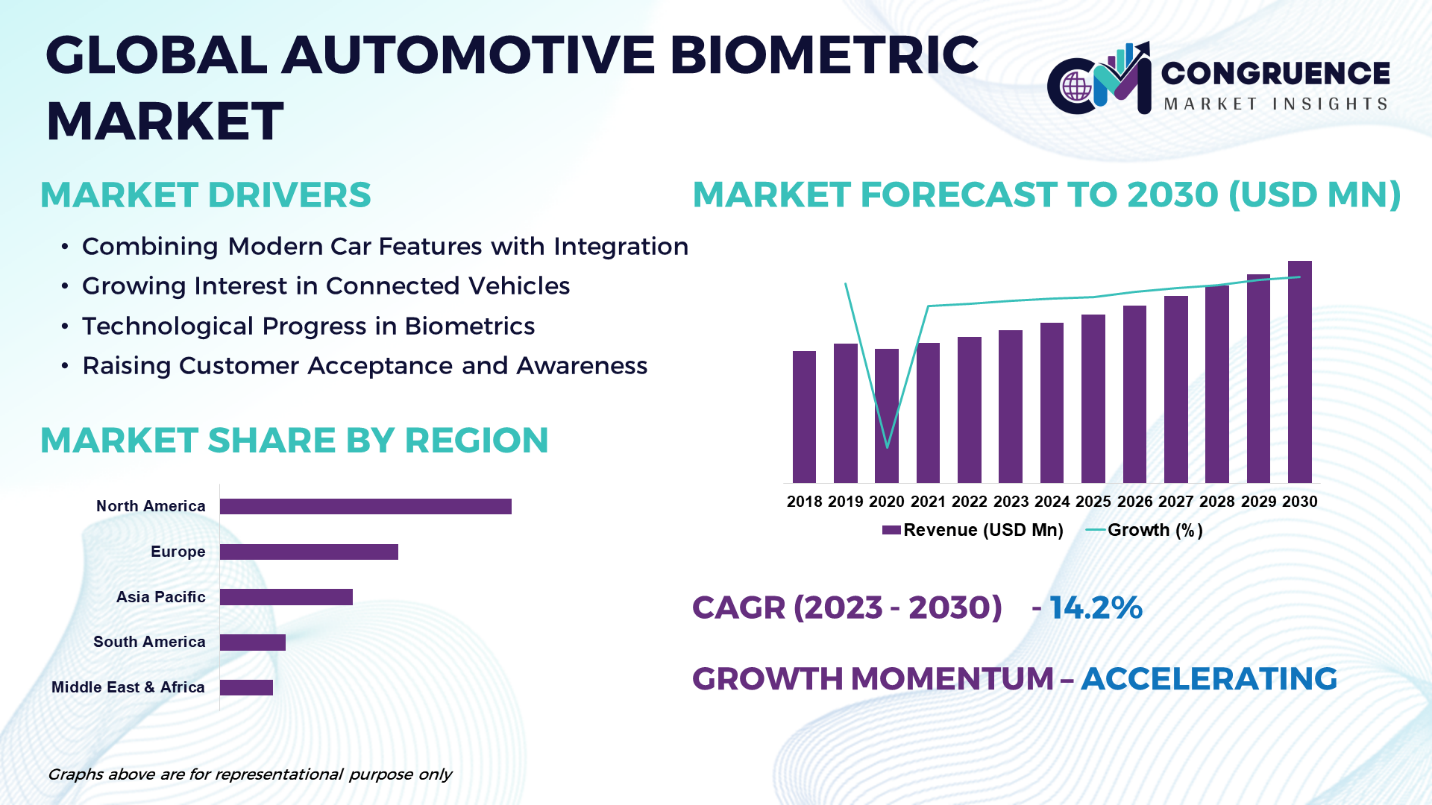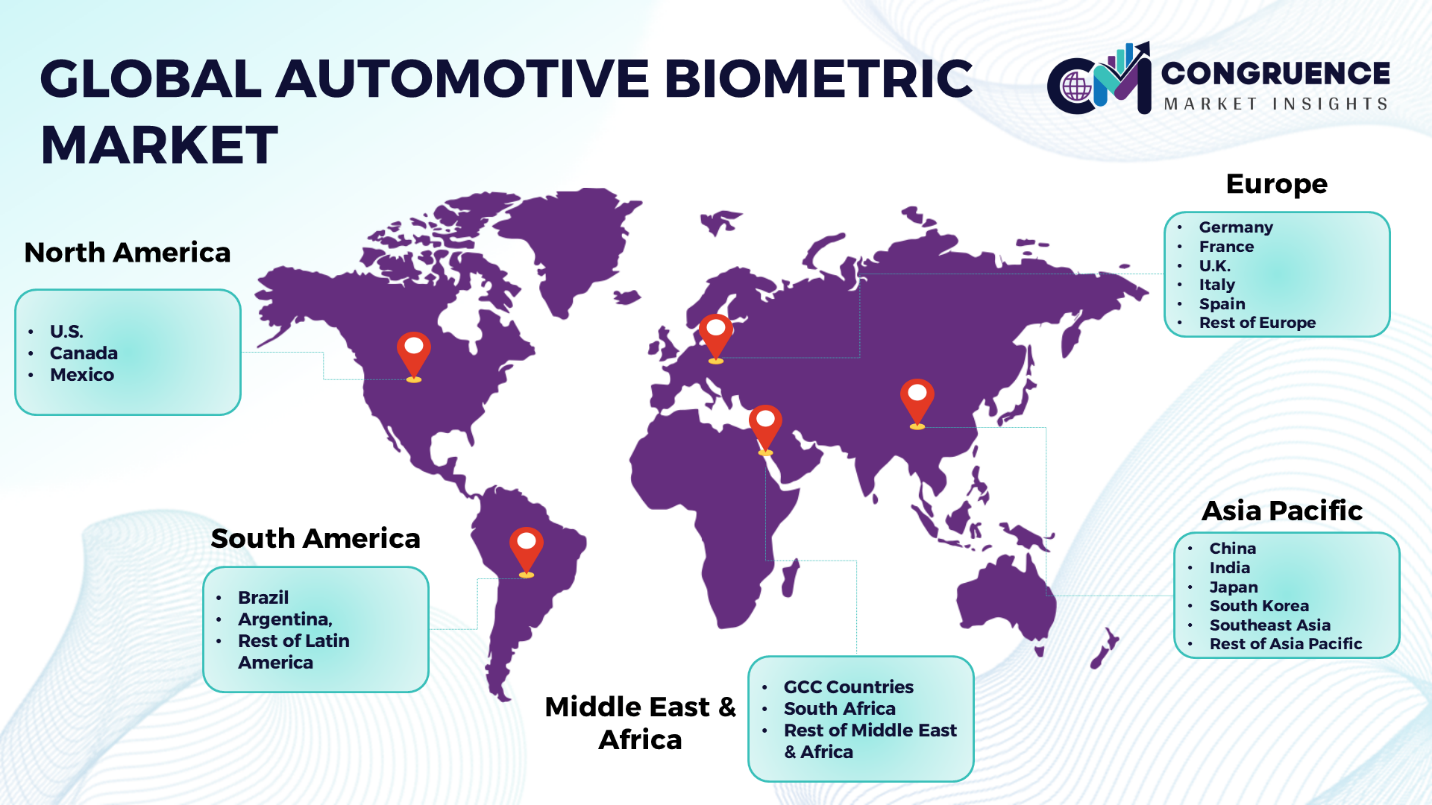Reports
The Global Automotive Biometric Market is expected to expand at a CAGR of 14.2% between 2023 and 2030. Advanced security features found in biometric identification systems aid in preventing unwanted access to driver and vehicle information. In the upcoming years, biometric identification technology is probably going to be seen mostly in mid-size cars. As customer worries about vehicle safety rise, more and more features are being included into various car models for improved security & use. As a result, there is a noticeable global increase in demand for automobile biometric identification systems. In an effort to ensure quality and dependability, industry players have begun to offer a variety of biometric identification systems, such as hand gestures, face and fingerprint recognition scanners, voice recognition software, iris-based in-car cameras, and more, with improved accuracy and reliability. Furthermore, biometric identification systems are incorporating behavior-based software and algorithms, which will propel the market's expansion in the upcoming years. The use of cutting-edge technologies including the Internet of Things (IoT), artificial intelligence (AI), and machine learning (ML) is being driven by the growing popularity of connected cars and the growing need for self-driving autonomous cars to improve driver comfort and convenience. This, in turn, is driving up demand for biometric systems, such as voice, fingerprint, and facial recognition, among others, to improve vehicle privacy and safety.

Automotive Biometric Market Major Driving Forces
Combining Modern Car Features with Integration: The integration of biometric identification systems into vehicles is becoming more sophisticated than just security and personalization as technology advances. An expanding number of car elements, including infotainment controls, driving assistance technologies, and ignition systems, are integrated with these systems. To avoid unwanted use, biometric ignition systems, for example, make sure that only authorized drivers are able to start the car. This functionality is very helpful in shared mobility services and commercial fleets to keep control over vehicle access and use.
Growing Interest in Connected Vehicles: The emergence of linked technologies and the Internet of Things (IoT) have led to an increase in demand for connected cars that provide smooth connectivity with infrastructure, networks, and other devices. This trend is well suited for biometric identification since it can be easily included into linked car ecosystems. Drivers can have a more comprehensive and integrated experience thanks to the sharing of biometric data with other devices. In addition to improving convenience, this also helps to make driving safer and more effective.
Technological Progress in Biometrics: Developments in biometrics are constantly broadening the scope and dependability of identifying systems. Biometric recognition is becoming faster and more accurate thanks to advances in algorithms, sensors, and data processing techniques. Owing to these technological developments, biometric identification systems now have fewer entry barriers, increasing their appeal to consumers and automakers alike.
Raising Customer Acceptance and Awareness: Customers are become more aware of the advantages and uses of biometric identification systems as they are implemented into more areas of daily life. More people are accepting these devices in cars as a result of this increased awareness. Automobile users are beginning to see the benefits of biometric identification as a tool for expediting their driving experiences in addition to its security value.
Automotive Biometric Market Key Opportunities
Integration with Vehicle Access and Start Systems: Automotive biometric solutions have the potential to smoothly integrate with vehicle access and start systems, offering safe and easy entry to cars without requiring conventional keys or fobs.
Personalized In-Car Experience: By identifying specific drivers and passengers and automatically modifying seat placements, climate settings, and infotainment preferences, biometric technologies offer the opportunity to customize the in-car experience.
Better Vehicle Security: By lowering the possibility of vehicle theft and unlawful entry, biometric authentication techniques such as fingerprint recognition, facial recognition, and iris scanning offer better security features.
Automotive Biometric Market Key Trends
· The use of biometric authentication in car access and start systems is growing.
· Increasing demand, fueled by biometric identification technologies, for customized in-car experiences.
· Emphasis on using biometric authentication techniques to improve vehicle security.
· Increasing emphasis on biometric sensor-based driver monitoring and safety.
· Integrating vehicle health monitoring systems with biometric authentication.
· Expansion of biometric authentication-based seamless payment integration.
· Possibilities for biometric authentication applications in fleet management.
· The use of biometric solutions is being driven by data security and regulatory compliance.
· Combining smart mobility solutions with biometric authentication.
· Working together with partners in the automotive ecosystem to promote market innovation and uptake.

Market Competition Landscape
Established businesses and up-and-coming competitors coexist in the competitive landscape of the global automotive biometric market. The market position of prominent firms is largely attributed to their wide-ranging production capacities, well-established distribution networks, and varied range of products, including automotive biometrics that are customized to suit distinct requirements. The ongoing emphasis on research and development initiatives also contributes to market competitiveness. To fulfill strict laws and changing customer needs, major manufacturers are making innovative investments to improve the quality and performance of automotive biometrics. Additionally, as businesses look to broaden their worldwide reach and penetrate new markets, strategic alliances and collaborations are a common trend. In addition, these companies frequently use mergers and acquisitions, regional growth, and acquisitions as methods to strengthen their industry positions. Prominent players in the market include:
· Hitachi Ltd.
· Synaptics Incorporated
· Fingerprint Cards AB
· VOXX International Corporation
· Nuance Communications, Inc.
· Continental AG
· Egis Technology Inc.
· Visteon Corporation
· Hyundai Mobis
· Methode Electronics, Inc.
· Gentex Corporation
· EyeLock LLC
· HARMAN International (Samsung Electronics)
· NXP Semiconductors N.V.
· HID Global (Assa Abloy AB)
|
Report Attribute/Metric |
Details |
|
Base Year |
2022 |
|
Forecast Period |
2023 – 2030 |
|
Historical Data |
2018 to 2022 |
|
Forecast Unit |
Value (US$ Mn) |
|
Key Report Deliverable |
Revenue Forecast, Growth Trends, Market Dynamics, Segmental Overview, Regional and Country-wise Analysis, Competition Landscape |
|
Segments Covered |
· By Authentication Type (Fingerprint Recognition, Facial Recognition, Iris Recognition, Voice Recognition) · By Application (Vehicle Access & Start System, Driver Monitoring & Safety, In-Car Personalization, Payment Integration) · By Vehicle Type (Passenger Cars, Commercial Vehicles) |
|
Geographies Covered |
North America: U.S., Canada and Mexico Europe: Germany, France, U.K., Italy, Spain, and Rest of Europe Asia Pacific: China, India, Japan, South Korea, Southeast Asia, and Rest of Asia Pacific South America: Brazil, Argentina, and Rest of Latin America Middle East & Africa: GCC Countries, South Africa, and Rest of Middle East & Africa |
|
Key Players Analyzed |
Hitachi Ltd., Synaptics Incorporated, Fingerprint Cards AB, VOXX International Corporation, Nuance Communications, Inc., Continental AG, Egis Technology Inc., Visteon Corporation, Hyundai Mobis, Methode Electronics, Inc., Gentex Corporation, EyeLock LLC, HARMAN International (Samsung Electronics), NXP Semiconductors N.V., HID Global (Assa Abloy AB) |
|
Customization & Pricing |
Available on Request (10% Customization is Free) |
